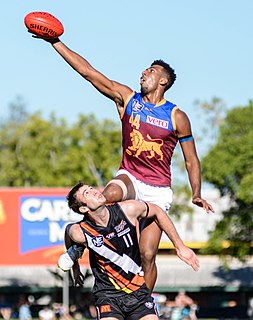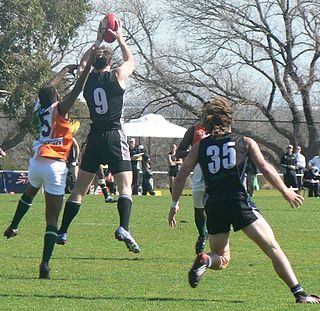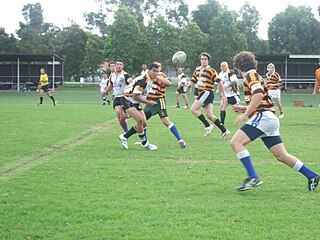Related Research Articles

Australian football, also called Australian rules football or Aussie rules, or more simply football or footy, is a contact sport played between two teams of 18 players on an oval field, often a modified cricket ground. Points are scored by kicking the oval ball between the central goal posts, or between a central and outer post.

The history of rugby league as a separate form of rugby football goes back to 1895 in Huddersfield, West Riding of Yorkshire when the Northern Rugby Football Union broke away from England's established Rugby Football Union to administer its own separate competition. Similar schisms occurred later in Australia and New Zealand in 1907. Gradually the rugby played in these breakaway competitions evolved into a distinctly separate sport that took its name from the professional leagues that administered it. Rugby league in England went on to set attendance and player payment records and rugby league in Australia became the most watched sport on television. The game also developed a significant place in the culture of France, New Zealand and several other Pacific Island nations, such as Papua New Guinea, where it has become the national sport.

Football in Australia refers to numerous codes which each have major shares of the mainstream sports market, media, broadcasting, professional athletes, financial performance and grassroots participation: Australian rules football, rugby league, rugby union and association football. There are four pre-eminent professional football competitions played in Australia: the Australian Football League, the National Rugby League, Super Rugby and the A-League (soccer). By most measures, including attendance, television audience and media presence across the most states, Australian football is the most popular nationally. However, in the states of New South Wales and Queensland, rugby football is overall the most watched and receives the most media coverage, especially the Rugby League State of Origin contested between the two states referred to as “Australian sport's greatest rivalry”. In recent times there has been an increase in popularity in Australian football and corresponding decrease in popularity of Rugby union in New South Wales and Queensland. Soccer, while extending its lead in participation rate particularly in the large cities and improving its performance at the FIFA World Cup, continues to attract the overall lowest attendance as well as media and public interest of the four codes.

The Adelaide Rams were an Australian professional rugby league football club based in Adelaide, South Australia. The team was formed in 1995 for the planned rebel Super League competition. The Rams lasted two seasons, the first in the Super League competition in 1997 and the second in the first season of the National Rugby League (NRL) in 1998. The Rams were not a successful club, winning only 13 out of 42 games. However crowd numbers in the first season were the fifth highest of any first-grade club that year, but dwindled to sixteenth in the second season. The Adelaide club was shut down at the end of the 1998 season as a result of poor on-field performances, dwindling crowd numbers, financial losses and a reduction in the number of teams in the NRL. They remain the only team from the state of South Australia to have participated in top-level rugby league in Australia.
John Ribot, also known by the nickname of "Reebs", is an Australian sports administrator, former rugby league footballer of the 1970s and 1980s. Once a Queensland State of Origin and Australian international representative, Ribot was the 1980 NSWRFL season's equal top try-scorer. Also a member of the 1982 "Invincibles" Kangaroo touring squad, he played club football in Brisbane for Fortitude Valley, Wests and Redcliffe, and in Sydney for Newtown, Wests and Manly-Warringah.

The laws of Australian rules football were first created by the Melbourne Football Club in 1859 and have been refined over the years as the sport evolved into its modern form. The laws significantly predate the advent of a governing body for the sport. The first national and international body, the Australasian Football Council (AFC), was formed in 1905 and became responsible for the laws, although individual leagues retained a wide discretion to vary them. Since 1994, after the establishment of a nation-wide Australian Football League (AFL), the rules for the game have been maintained by the AFL Commission through its AFL Competition Committee.

Australian rules football in New Zealand is notable as the first colony outside of Australia to take up the sport as early as the 1860s. The official name for the sport between 1890 and 1914 was Australasian Football in acknowledgement of New Zealand's participation. After a half century hiatus of organised competition, it has grown rapidly as an amateur sport. Today there are more than five organised competitions located in various regions across the country including Auckland; Canterbury; Wellington; Waikato; Otago, Queenstown and a four-team national competition with a national draft has been contested at the North Harbour Stadium in Auckland since 2016. The national team, The Hawks, have competed against the AFL Academy and were crowned International champions in 2005.

Australian rules football in New South Wales dates back to 1866 with organised competition being continuous since the 1880s. Today several regions are strongholds of the sport, including Broken Hill near South Australia, and the Riverina and the South Coast near Victoria. In other, more populous areas of New South Wales, including Sydney, Australian football trails behind rugby league in popularity. The AFL NSW/ACT is the governing body of the sport across the state and the Australian Capital Territory.
Michael David O'Connor is an Australian former rugby league and rugby union footballer who represented Australia in both codes. He played for the Wallabies in 13 Tests from 1979 to 1982 and then the Kangaroos in 17 Tests from 1985 to 1990. O'Connor played club football in the NSWRL Premiership for the St. George Dragons from 1983 until 1986, and later the Manly-Warringah Sea Eagles from 1987 until his retirement at the end of 1992, becoming captain of Manly in 1990, as well as winning the 1987 Winfield Cup with the Sea Eagles.

Dan Frawley (1882–1967) was a pioneer Australian rugby league footballer, a national representative player. He played his career as a wing with the Eastern Suburbs club in Sydney and is considered one of the nation's finest footballers of the 20th century. A fast and agile wing, with an ability to effortlessly change direction, Frawley was at club and representative levels generally positioned on the outside of rugby league Immortal Dally Messenger, creating a formidable combination. He was a noted speedster who, on the 1908–09 Kangaroo tour of Great Britain, was acclaimed as the "100 yards champion" of the squad.

The Australian National Football Council (ANFC) was the national governing body for Australian rules football in Australia from 1906 until 1995. The council was a body of delegates representing each of the sport's individual state leagues which controlled football in their states. The council was the owner of the laws of the game and managed interstate administrative and football matters. Its function was superseded by the AFL Commission.
The 1980 State of Origin game was the first game between the Queensland Maroons and the New South Wales Blues rugby league teams to be played under "state of origin" selection rules. It was the third match of 1980's annual interstate series between the Blues and the Maroons, and was only allowed to go ahead because the first two matches were already won by New South Wales under established 'state of residency' rules. It was played on 8 July 1980 under the newly configured rules by which a player would represent his "state of origin", i.e. the state in which he was born or in which he started playing registered first grade rugby league football.
The 1987 NSWRL season was the 80th season of professional rugby league football in Australia. Thirteen clubs competed for the New South Wales Rugby League premiership's J J Giltinan Shield and Winfield Cup during the season, which culminated in the grand final between the Manly-Warringah Sea Eagles and the Canberra Raiders who were the first club ever from outside Sydney to appear in a premiership decider. This season, NSWRL teams also competed for the 1987 National Panasonic Cup.
The 1981 State of Origin game was the second such match between arch rivals Queensland and New South Wales to be played under State of Origin selection rules. Again it was played as the third game of an already-decided 3-game series. New South Wales' victories in the first two games under the "state of residency" selection rules were, however, the last matches of this kind to ever be played as the following year the Origin concept was fully embraced.
Variations of Australian rules football are games or activities based on or similar to the game of Australian rules football, in which the player uses common Australian rules football skills. They range in player numbers from 2 up to the minimum 38 required for a full Australian rules football.

Rugby league, in New South Wales, is the most popular participation and spectator sport. It currently has the highest attendance and television audiences of the various codes of football in the state, far outstripping any other competitors. The state has over 400,000 active participants in the sport with a further 1 million playing the sport in schools, over 500 active clubs across the state, and 10 clubs in the national professional competition, named the NRL.
In rugby league football, the Laws of the Game are the rules governing how the sport is played. The Laws are the responsibility of the Rugby League International Federation, and cover the play, officiating, equipment and procedures of the game.
Rugby union has a long history in Australia, with the first club being formed in 1863 at Sydney University. Today it holds tier one status with World Rugby and has over 82,000 players nationwide.
The Australian rules football schism (1938–1949) was a period of division in the rules and governance of Australian rules football, primarily in the sport's traditional heartland of Melbourne, and to lesser extents in North West Tasmania and parts of regional Victoria. The schism existed primarily between Melbourne's pre-eminent league, the Victorian Football League (VFL), and its secondary league, the Victorian Football Association (VFA). In the context of VFA history, this period is often referred to as the throw-pass era.

Cornelius Michael "Con" Hickey was an Australian rules football player and administrator for the Fitzroy Football Club, and administrator for the Victorian Football League (VFL) and the Australian National Football Council (ANFC).
References
- ↑ AFL Queensland
- ↑ AUCKLAND STAR, VOLUME XXVI, ISSUE 4533, 9 DECEMBER 1884, PAGE 2
- ↑ "Universal Football – conference in Melbourne". The Evening Star. Boulder, WA. 20 August 1908. p. 3.
- ↑ Rover (28 September 1908). "Retrospect of the football season". Evening Journal. Adelaide, SA. p. 2.
- ↑ "UNIVERSAL FOOTBALL". The Empire . Vol. II, no. 67. Western Australia. 29 August 1908. p. 3. Retrieved 14 November 2021– via National Library of Australia.
- ↑ "Football carnival – Queensland defeated". Leader. Melbourne, VIC. 15 August 1914. pp. 20–21.
- 1 2 3 4 Pivot (28 November 1914). "Football amalgamation – Australian and rugby codes". Leader. Melbourne, VIC. p. 21.
- 1 2 3 4 5 J. W. (24 April 1915). "The amalgamation scheme". The Australasian. Vol. XCVIII, no. 2560. Melbourne, VIC. p. 819.
- 1 2 "Practice games – the amalgamation idea". The Argus. Melbourne, VIC. 16 April 1915. p. 12.
- 1 2 3 Aus. (12 February 1915). "Football – New game explained". Westralian Worker. Perth, WA. p. 8.
- ↑ "Rival football games". Barrier Miner. Broken Hill, NSW. 21 November 1914. p. 8.
- ↑ "Football amalgamation – Sydney league favourable". The Age. Melbourne, VIC. 25 November 1914. p. 11.
- 1 2 "Football reform". The Register. Adelaide, SA. 23 January 1915. p. 7.
- ↑ "National football". The Age. Melbourne, VIC. 17 April 1915. p. 12.
- ↑ "Football amalgamation". The Sydney Morning Herald. Sydney, NSW. 2 February 1915. p. 10.
- ↑ "Meeting of the W.A.F.L.". The West Australian. Perth, WA. 4 March 1915. p. 4.
- ↑ Boundary (1 May 1915). "Football – Australian game". The West Australian. Perth, WA. p. 9.
- ↑ "Australian rules game". The Sydney Morning Herald. Sydney, NSW. 17 April 1915. p. 20.
- ↑ "Annual meeting of the league – the proposed universal code". The Mercury. Hobart, TAS. 30 March 1915. p. 8.
- ↑ "Queensland Rugby League". Gympie Times and Mary River Mining Gazette. Vol. XLVIII, no. 7358. Gympie, QLD. 3 April 1915. p. 4.
- 1 2 "Australian Football Council". The Age. Melbourne, VIC. 30 December 1919. p. 7.
- ↑ FOOTBALL AMALGAMATION. AUCKLAND STAR, VOLUME XLV, ISSUE 276, 19 NOVEMBER 1914, PAGE 6
- ↑ AUCKLAND STAR, VOLUME XLV, ISSUE 290, 5 DECEMBER 1914, PAGE 2 (SUPPLEMENT)
- ↑ THE NEWER FOOTBALL. SUN (CHRISTCHURCH), VOLUME I, ISSUE 311, 5 FEBRUARY 1915, PAGE 2
- ↑ "One common code of football for Australia". Referee. Sydney, NSW. 20 July 1933. p. 1.
- 1 2 "Football codes – conference ends". The Sydney Morning Herald. Sydney, NSW. 12 August 1933. p. 14.
- ↑ "New game of football". Recorder. Port Pirie, SA. 12 August 1933. p. 1.
- ↑ "The new game – trial matches in Sydney". Advocate. Burnie, TAS. 12 August 1933. p. 7.
- ↑ "To be dropped – proposed amalgamation – football codes". Newcastle Morning Herald and Miners' Advocate. Newcastle, NSW. 15 August 1933. p. 8.
- ↑ "Australasian Football Council". The Age. Melbourne, VIC. 29 December 1919. p. 5.